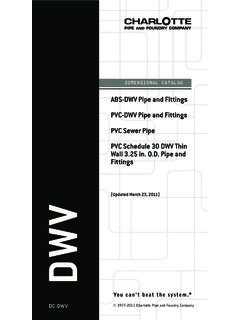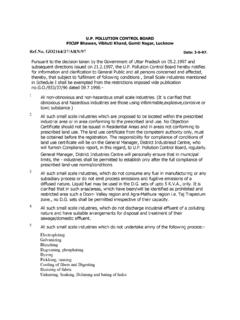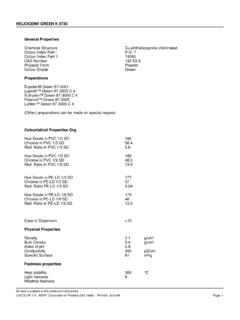Transcription of READ ALL DIRECTIONS CAREFULLY BEFORE ... - Brower Equip
1 INSTRUCTIONS MC - MH - MJ - MK. AND REPAIR PARTS LIST SERIES AUTOMATIC. WARRANTY INFORMATION WATERERS. read ALL DIRECTIONS CAREFULLY BEFORE BEGINNING INSTALLATION. ! WARNING ! 1. INSTALLATION MUST BE MADE AND MAINTAINED IN STRICT ACCORDANCE WITH NATIONAL/. LOCAL PLUMBING AND NATIONAL/LOCAL ELECTRICAL CODES (CSA IN CANADA). INSTALLA- TION MUST BE MADE BY A QUALIFIED ELECTRICIAN. THE IMPROPER ELECTRICAL INSTALLA- TION AND MAINTENANCE MAY RESULT IN SERIOUS INJURY OR DEATH FOR PERSONNEL OR. LIVESTOCK. 2. EACH ELECTRICAL UNIT MUST BE WIRED THROUGH A FUSED SWITCH BOX AND FUSED AC- CORDING TO AMPS REQUIRED FOR EACH SPECIFIED ELECTRIC UNIT. SEE EXHIBIT A. CANA- DIAN ELECTRICAL CODE - - PART 1 REQUIRES LIVESTOCK WATERERS INSTALLED IN FEED- LOTS IN OPEN FEEDING AREAS TO BE GROUNDED BY A SEPERATE STRANDED COPPER. GROUNDING CONDUCTOR OF AT LEAST NO. 6 AWG TERMINATING AT A POINT WHERE THE. BRANCH CIRCUIT RECEIVES ITS SUPPLY.
2 3. THIS UNIT MUST BE GROUNDED TO A COPPER GROUND ROD 5/8 ( ) DIAMETER BURIED. AT LEAST 8 FEET ( METERS) IN UNDISTURBED SOIL. SEE EXHIBIT A. We know that you will be pleased with your decision to purchase a Brower waterer. Please take time to familiarize yourself with this manual. Included are tips that will make use of your waterer more trouble free and more economical. Red and white Brower waterers were marketed under the Marlor label for 25 years. Marlor waterers carried a light green and white color scheme. Brower parts will service most Marlor waterers. This instruction manual covers the following model numbers: MC32E, MC32N, MK32HE, MK32HN, MJ31HE, MJ31HN, MC32HE, MC32HN, MH30E, MH30N. Equipment for poultry livestock pets Box 2000, houghton, iowa 52631, usa ISBWATERER. COPYRIGHT 2010 Brower telephone 319-469-4141 fax 319-469-4402 Rev. ALL RIGHTS RESERVED e-mail: web: PRINTED IN EXHIBIT A. 2. INSTALLATION.
3 1 LOCATION: Locate waterer in a place sheltered from the prevailing winds for reduced energy consumption. Install the waterer 25 feet or more from self-feeders or bunk feeders to reduce the amount of feed and salt that is dropped into the waterer. 2 WATER SUPPLY LINE: Horizontal underground waterline should be sized to account for any pressure drop relat- ing to distance. The vertical supply pipe should be rigid plastic, copper or galvanized. We suggest you use a 1/2 . ( cm) pipe for hog waterers and a ( cm) for cattle waterers. Water lines over 50 feet ( m) should be one inch ( cm), or larger. Use of undersized feeder pipe causes excessive pressure drop and loss of recovery capacity of waterer. Models are equipped with the following for supply connection: MH- inch ( cm), MC, MJ, and MK inch (.635 cm). A shutoff valve should be provided under the waterer to shut off water when servicing. Flush supply pipe thoroughly BEFORE connecting to fountain.
4 Water supply with foreign material such as sand, rust, etc. may require a filter to keep valve working properly. The full length of the vertical supply pipe must be centered in a 6-inch ( cm) (or larger if the waterer will accom- modate it) riser tile or PVC casing. Extend the tile from a point 1 inch ( cm) above the top of your platform to a point below the frost line. DO NOT place insulation or other materials in the tile. This will stop the air flow and cause water line to freeze up. 3 MOUNTING PAD: Waterer must be mounted on a concrete pad. The pad should be sloped about one-quarter inch per foot away from the waterer. We recommend a minimum thickness of four inches ( cm). The size of the pad is left to the user's discretion but we suggest you pour a pad large enough for livestock to stand on while drink- ing. This is about 8' square (.75 square meter) for MC, MJ, and MK models and 16' square ( square meters) for model MH.
5 An additional 4 ( cm) pedestal (on top of the pad) extending 8 inches ( cm) from the waterer on all four sides will provide protection from livestock backing up to or rubbing against the waterer. It will also pro- tect it from manure and manure handling equipment. A rough broom finish to the concrete surface provides a better footing for livestock. BE SURE TO PLACE A COPPER GROUND ROD TO USE IN GROUNDING THE WATERER AS SHOWN IN EX- HIBIT A. THE WATERER MUST BE GROUNDED AT LEAST 8 FEET ( meters) INTO THE GROUND. 4 SETTING THE WATERER: Once the concrete is firm, mark the concrete for bolts by referring to Exhibits B, C, and D. Space the bolts so you can easily line up the inlet pipe connection in the waterer. It is advisable to make a tem- plate of the base of the waterer to check holes BEFORE the concrete is set. Alternatively, you may wish to mark the concrete after it has set and drill holes to hold the anchor bolts.
6 Install four 3/8 (.95 cm) x 5 ( cm) bolts (not included) in the concrete. When the concrete is dry, we recommend that you caulk (all weather sealant) the area of waterer base contact. This will prevent air from leaking under the waterer and decreasing energy efficiency. Also a sheet of aluminum foil placed over the concrete pad inside the waterer will reduce heat loss. 5 CONNECTION TO SUPPLY LINE: Connect a hose or pipe fitting to the shutoff valve at the top of the concrete. Cut hose or pipe to proper length and connect to waterer. A flexible connector should be used with a small S shape to relieve strain if frost heaving is possible. An inflexible connection should use a swing joint: to prevent frost heave problems. Hose or pipe should not touch the outside surface of fountain or heating element. 6 FLOAT ADJUSTMENT: The water level in the trough is varied by changing the float position. Loosen the wing screw and try various float positions until the desired level is attained.
7 If a relatively consistent water level cannot be main- tained, the problem is most likely a widely varying pressure (more than 20 psi) in the system. In such a case the basic cause of the trouble must be corrected to get proper operation of the valve. Tighten wing screw securely. If the float, bounces, valve chatter, or you have a pounding noise in the water line when a waterer turns off or on, it is usually due to an excessive amount of air in your water line. In most situations this can be corrected by using a smaller orifice to cut down the water opening in your valve. (See paragraph 7). After replacing the float and valve cover, drain and refill the trough several times to ensure that the float arm oper- ates freely. 3. BASE DIMENSIONS. 4. MA31E/MA31N/MA31HE/MA31HN. MC32E/MC32N/MC32HE/MC32HN. MJ31HE/MJ31HN. MK32HE/MK32HN. SUPER INSULATED LIVESTOCK WATERER. VALVE PART NO. VP126. EXHIBIT E. Ref. No.
8 Part No. Description Qty 1 VP19 Power Link, Plastic 1. 2 VP110 Cam Link, Plastic 1. 3 VP11 Valve Body, Plastic 1. 4 VP111 Link Pin, Plastic 2. 5 VP18 Plunger, Plastic 1. 6 VP113 Diaphragm, Rubber 1. 7 VP114 5. /32 Orifice, Plastic 1 12. 8 VP112 5. /8 Orifice, Rubber 1. 9 VP118 Base 1/2 OD, Brass 1. 10 VP15 Assembly Nut, Plastic 1. 11 VP115* Adjust Screw, Plastic 1. 12 VA225P* Float Arm, 1 1/8 , Plastic 1. *VP115 Adjust Screw and VA225P* Float Arm are not included. You must order these two parts seperately. These models use Float Part No. OP286, a 4 round poly float. The float needs to be ordered seperately. MF30E/MF30N. MH30E/MH30N. ML30E/ML30N. SUPER INSULATED LIVESTOCK WATERER. VALVE PART NO. VP126. EXHIBIT F. Ref. No. Part No. Description Qty 1 VP19 Power Link, Plastic 1. 2 VP110 Cam Link, Plastic 1. 3 VP11 Valve Body, Plastic 1. 4 VP111 Link Pin, Plastic 2. 5 VP18 Plunger, Plastic 1 12. 6 VP113 Diaphragm, Rubber 1.
9 7 VP16 1. /4 Orifice, Plastic 1. 8 VP112 5. /8 O Ring x .103 Neoprene 1. 9 VP13 Base, 3/4 OD x 1/4 ID, Plastic 1. 10 VP15 Assembly Nut, Plastic 1. 11 VP115* Adjust Screw, Plastic 1. 12 WC726P* Float Arm, Plastic, 3 5/8 1. *VP115 Adjust Screw and WC726P Float Arm are not included. You must order these two parts seperately. These models use float Part No. A405P, a 4 x 5 black poly float. The float needs to be ordered seperately. 5. If the float should catch on any part of the waterer, its lateral position can be changed by loosening the large as- sembly nut (VP15) and turning the valve body slightly. If float is rubbing on the insulation in the valve cover you can trim the insulation with an ordinary knife. 7 VALVE ADJUSTMENT: All Brower pressure waterers are equipped with valves with interchangeable orifices when shipped. This dependable valve has served our customers since 1975. The standard valve for your unit normally operates on a range of 20 to 60 psi.
10 When your waterer is installed on a gravity flow or low pressure system, you may adjust your valves for more water volume by using a larger orifice in the valve. If your waterer is installed on a high pressure water system (over 60 pounds) you may compensate for extra pressure by using a smaller orifice in the valve. For severe high pressure situations, you may need to install a pressure regulator. See EXHIBITS E & F for valve repair parts. Table 1 shows valve capacities in gallons per minute at various pres- sures. Table 1. VP1 VALVE CAPACITIES. Gallons Per Minute VP1-14 VP1-6 VP1-7. PSI 5/32 Orifice 1/4 Orifice 3/8 Orifice 20 40 60 80 CAUSES OF INADEQUATE PRESSURE INCLUDE: WELL DEPTH: If you have a shallow well, a deep well will probably solve the water shortage problem. If the water- yielding capacity of the aquifer (water-bearing stratum) is less than your demand for water, install a storage tank SIZE OF WELL CASING: If you have a large pump on a small diameter well and the water output is slow, then pos- sibly your well diameter is too small.







